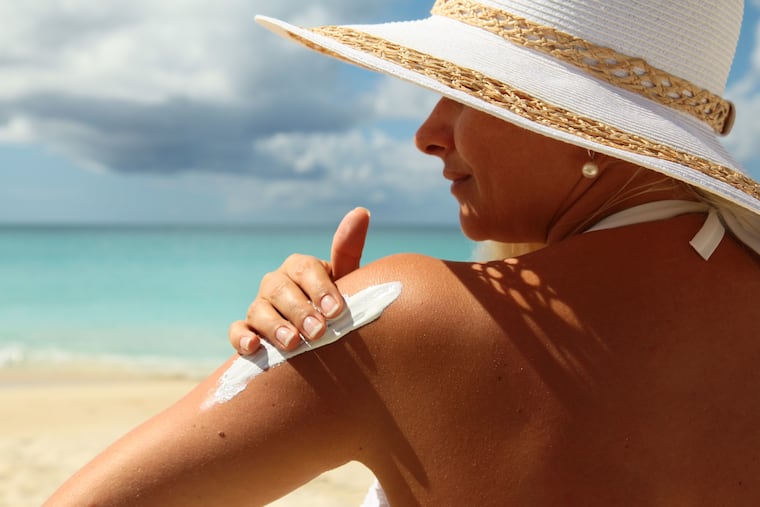That summer tan is deadly. Wear sunscreen!
Go outside, but be responsible and wear sunscreen: no tan is safe or worth the risk.

Not sure how to practice sun safety? You are not alone. Dermatologists have a complicated relationship with the sun also. Research has shown that ultraviolet rays from the sun are directly connected to skin cancers. On the other hand, as doctors, we harness the power of these rays to treat certain diseases, such as psoriasis, eczema, vitiligo, and cutaneous T-cell lymphoma.
As with everything in life, we can enjoy the sun in moderation -- with a few precautions.
First and foremost, go to the beach!
Go outside! Enjoy your life! But, be responsible and acknowledge the risks. I don’t lecture my patients for past overexposures. It’s true that we didn’t necessarily know better back in the day, so no need to apologize for having a good time. But we now know that ultraviolet light is a carcinogen, so we as dermatologists are obligated to advise you to minimize exposure. Putting it into perspective, it’s not nearly as bad as smoking cigarettes, but with a smart strategy, your risk should be minimal.
But don’t we need the sun to get enough Vitamin D?
Not exactly. To be fair, this is controversial, but the consensus among dermatologists is that the healthiest way to get vitamin D is through your diet or as a supplement. Ultraviolet B radiation does help people get vitamin D, but a recent study in the British Journal of Dermatology provided evidence that when properly applied, sunscreen does not prevent people from getting sufficient vitamin D.
Don’t believe the myth that you should burn first or get a base tan.
There is no such thing as a safe tan. (Except sunless tanners or spray tans, which are definitely OK!) Any tan or burn is a direct reflection of your skin sustaining DNA damage. Though tans do help protect against future exposure, it’s not worth it. Wear sunscreen!
If you need extra incentive to wear sunscreen, you should remember that it also prevents aging and wrinkling.
Even more important than any sunscreen is to avoid unnecessary sunlight, especially when it’s at its strongest, from 10 a.m. to 2 p.m. Stay in the shade, wear wide-brimmed hats, UV-protective clothing, and long sleeves. Keep in mind that you can still get burned on cloudy days, as most ultraviolet light still gets through.
Which sunscreen should you use?
The best sunscreen is the one that you will feel comfortable using day in and day out. It’s a personal preference. You can use a fancy one, such as the top-rated (per Consumer Reports) La Roche-Posay Anthelios, but it will set you back $36 a bottle. There are many brands that Consumer Reports rated almost as good but at a cost of less than $10, including Equate, Bullfrog, and Coppertone sunscreens. I buy all my own sunscreen (no free samples for me, so you can trust me, no conflicts), and for me, it’s simply not worth the extra expense to get the fancy stuff. But for some people, it may be worth the finer textures and easier application.
What about SPF?
The American Academy of Dermatology recommends you look for a sun protection factor (SPF) of 30 or greater. Above this number, sunscreens are essentially equivalent — SPF 30 = 97 percent protection, SPF 50 = 99 percent protection. So if the high number costs a lot more, don’t be taken advantage of. The key is to use enough of it – around a shot-glass-full, per application – and reapply every two hours or after you’ve been swimming or have sweated it off, since no sunscreen is waterproof.
Many people also use moisturizers that include SPF. While these should add protection, I recommend specifically wearing a separate sunscreen, applied in adequate amounts.
How about spray sunscreens?
They do offer easier application, so they are better than nothing. However, I find that with sprays, people frequently miss areas, and apply much less than they need. Also, there is the question of whether accidentally inhaling any could be harmful.
What about mineral or natural sunscreens?
Sunscreens work through two main types of active ingredients, either chemical absorbers or mineral-based physical blockers. The mineral sunscreens, with active ingredients zinc oxide and titanium dioxide, are the best protection since they reflect and refract sunlight. However, they are harder to rub in (think: the lifeguard with the white nose).
What about kids and sunscreen?
The American Academy of Dermatology recommends using sunscreen on children after six months; Infants younger than that should stay in the shade or be covered.
Can sunscreens be absorbed in our bodies or damage the environment?
The chemical absorbers in sunscreen are designed to absorb ultraviolet light. These ingredients, such as oxybenzone and avobenzone, have been detected in the blood of people using chemical absorber sunscreens, but to be clear, no toxic effects have been identified in humans. Similarly, these chemical absorbers have been detected in worldwide water sources, and it is possible they could be contributing to bleaching the coral reefs. Though dermatologists feel that wearing any sunscreen is safer than sun exposure, mineral sunscreens (zinc oxide, titanium dioxide) do not have any such concerns.
Jules B. Lipoff is a dermatologist and assistant professor of clinical dermatology at the Perelman School of Medicine at the University of Pennsylvania.